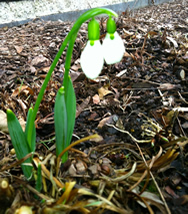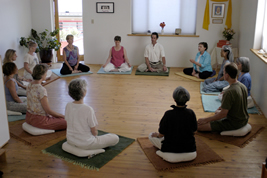
Whenever I go to study at my Vedic Chant workshops I learn something new – something that will not only help me to move forward in my chanting, but something that also can help me live my life with greater focus, peace, and self-confidence.
Before our workshop ended, Sonia Nelson, our “guru” of Vedic Chant, explained how we might approach our own chanting study once we were home and on our own. She did this by focusing on how we might behave when we see we are making a mistake in our chanting practice.
The first way she called the “OMG” reaction. We hear ourselves stumbling in our chanting, and we react as if our mistake is a crisis – “oh, my god.” As Sonia explained, this reaction creates fertile ground for the antarayas or obstacles, as described in Yoga Sutra I.30-31, to grow. Thoughts of self-doubt can arise about our ability to chant or what our teacher might think. As the reaction plays out, we may feel defeated in our endeavor, the mind is disturbed, we feel anxious, and we suffer. As this unfolds, we lose any opportunity to determine how we might proceed to deal with the mistake, itself.
The second way she called the “OOPS” response. We hear a mistake in our chanting and stop with “oops, what happened here?” Then we look more closely at the mistake to see how we might deal with it. Perhaps we need to break a phrase into syllables – small chunks – to practice and correct the error. Then we can rebuild the phrase by focusing on the syllable, adding another, chanting it several times, and adding another until we can chant the entire line correctly.
What we do not do with the “OOPS” response is trigger a crisis in our bodies and minds. Instead, our minds remain clear so we can move forward rather than staying stuck.
By now you can probably see how this model can help us in our everyday lives. We free ourselves from having to anxiously try to make every endeavor “perfect,” which, of course, we never can do. Nor do we have to pillory ourselves for every mistake. Instead, we can determine calmly the best action to take.
Chapter II of the Yoga Sutra gives us the eight limbs of yoga as a path to “discernment and clear perception.” The first limb or yama prescribes five principles to guide our relationships. The first principle is ahimsa, which is considered the most important. Ahimsa is the practice of “nonhurtfulness toward others and ourselves,” according to Nicolai Bachman in The Path of the Yoga Sutras. He goes on to say, “A nonjudgmental and forgiving attitude is essential to practicing ahimsa.”
I ask you to reflect: if you wish to make ahimsa a principle you practice, how are you going to respond to your mistakes – “OMG” or “OOPS?”



 Visualization can be a powerful tool of yoga, especially when the visualization focuses on an object in nature. One of the most revered objects of visualization and meditation in yoga is the sun.
Visualization can be a powerful tool of yoga, especially when the visualization focuses on an object in nature. One of the most revered objects of visualization and meditation in yoga is the sun. 
 If you attended my yoga classes, you probably have had the experience of chanting a word or words in Sanskrit. The words I would have chosen for us to chant would have supported the focus for the class. For example, if we were focusing on the concept of “peace,” we would chant the Sanskrit word for peace, “shanti,” and allow that sound to help create a sense of peace in our bodies, our breath, our minds, and our hearts.
If you attended my yoga classes, you probably have had the experience of chanting a word or words in Sanskrit. The words I would have chosen for us to chant would have supported the focus for the class. For example, if we were focusing on the concept of “peace,” we would chant the Sanskrit word for peace, “shanti,” and allow that sound to help create a sense of peace in our bodies, our breath, our minds, and our hearts.